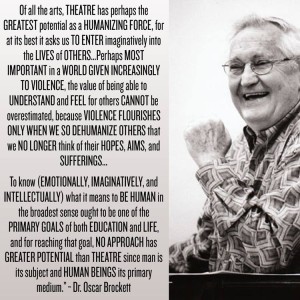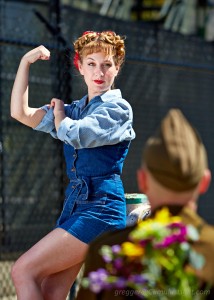Review: THE SPANISH TRAGEDY at the Marin Shakespeare Company
July 25, 2013 § Leave a Comment
A 425 Year-Old Debutante
For fans of Shakespeare and his contemporaries, the warmth of summer brings in the feasting season. Dessert this year is the Marin Shakespeare Company’s production of the rarely performed Thomas Kyd masterpiece, The Spanish Tragedy. (In fact, after 425 years it is said to be making its Northern California debut.)

Hieronimo, Knight-Marshal of Spain (Julian Lopez-Morillas) mourns for his murdered son Horatio (Erik Johnson) in Marin Shakespeare Company’s outdoor production of Thomas Kyd’s “The Spanish Tragedy.”
Photo by Eric Chazankin
The plot of Kyd’s revenge tragedy has more than a passing resemblance to Hamlet, a comparison from which it usually suffers but which also supplies it endless fascination. Although its date of composition is uncertain most scholars place it in the mid-to-late 1580s at just about the same time Shakespeare was probably starting his career in London. It is some dozen years older than Shakespeare’s Hamlet, a model therefore, and not a copy.
Spanish Tragedy opens with a ghost seeking revenge – accompanied in the play by a character named Revenge, in fact. It also features a doubting and delaying revenger who feigns madness to buy time, a woman driven genuinely mad by loss who eventually commits suicide, and a decisive play-within-a-play. Solely on the evidence of this resemblance, in fact, Kyd is believed to be the author of the mysterious ur-Hamlet, the now lost play on which Shakespeare is thought to have based his version.
The misfortune of the Spanish Tragedy is that through most of the twentieth century it was usually studied not because it is the progenitor of the revenge tragedies that dominated the Elizabethan stage, although it is, but as a less subtle comparator to Hamlet, useful for teleological arguments “proving” Shakespeare’s genius. Theater companies have had little incentive to produce it because the inevitable criticism is that it is nothing but a sensational oddity from the dustbins of history.
Body Counts and Comparisons
Among the things that becomes clear from watching the play in performance in Marin (from an edition prepared by the company’s skillful dramaturg, Mary Ann Koory) is that Hamlet is the wrong comparator. It is far more like Shakespeare’s first – and decidedly unsubtle – revenge tragedy, Titus Andronicus. It has a plotting Iago-ish Machiavellian character at its center, like Titus’ Aaron. The revenger is not a son, but a father, like Titus. A powerful woman drives the plot forward, like Tamora. Most of all, it is not structured around introspective monologues, but (exactly like Titus) around grisly and horrific violence – lots and lots of violence. If you are not familiar with Titus, the Royal Shakespeare Company has prepared a helpful graphic of the body count for its current production, attached here.
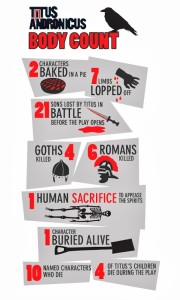
The Royal Shakespeare’s infographic of the Titus body count, to which Spanish Tragedy is a worthy rival.
Similarly, The Spanish Tragedy begins with a murdered minor nobleman, Don Andrea, tallying the deaths from a war in which, by the rules of chivalry, he would have been taken prisoner for ransom instead of killed. It proceeds through the onstage murder of a bound victim, two ambushes of unsuspecting co-conspirators to eliminate witnesses, a narrowly averted burning at the stake of an innocent man, an unexpected hanging of a guilty one who thought he had bribed his way to freedom, an offstage suicide, a final scene with so many deaths that it leaves the lines of succession of both Spain and Portugal destroyed, and the hero biting out his own tongue so he cannot be forced to confess!
Before “To be, or not to be” there was “Oh eyes, no eyes”
Titus, of course, was not held in high esteem until very recently, when it began to be judged by its own Senecan aesthetic aims instead of belittled for not being more like the late tragedies. Ironically, it was Shakespeare’s most successful play in his lifetime. It did not hold a candle to Spanish Tragedy, however, which was the most successful play of the entire period. It has more recorded performances and more references in plays, poems, and diaries than any play before the Commonwealth. What “To be or not to be” is to us now, the protagonist, Hieronimo’s, great speech “Oh eyes, no eyes, but fountains fraught with tears” was to the early modern audience then.
Julian Lopez-Morillas plays Hieronimo with a riveting intensity throughout, but his delivery of the famous monologue confirmed its still current fascination, as he used it to shift the action into a higher gear. His dark humor and grisly determination had the same kind of power that Antony Hopkins brought to Julia Taymor’s filmed Titus. In his hands we begin to see what all the fuss was about.
Few in the cast could keep pace with him, but Elena Wright was an intriguing (in both senses of the word) Bellimperia, the female lead around whom much of the plot turns. Female characters from the period generally do not have the agency and intensity that Bellimperia has, and Wright reveled in the chance to play her strength. Erik Johnson was a very charismatic Horatio, the young man in love with her, and the presumed revenger, until he is captured and casually murdered in front of her (and us) midway through the play. Scott Coopwood played Bellimperia’s father, a particularly complex role, notably.
It is carping to note that much of the rest of the very large cast was less experienced, since the economic reality is that is about the only way any company could afford to mount this show. The divide between the professionals and the others was wide, however, and both the pace and the verse speaking suffered often because of it. The production’s strengths were heavily invested in the protagonists, unbalancing the action when the antagonists were (at least theatrically) not their match. A surprising set of comic characters who seem to have wandered into the tragedy from Much Ado, however, helped to energize the second half.
Beautiful Executions
Set Designer Shannon Walsh created a beautiful and varied Spanish compound, but for some reason chose not to structure any visual relationship between the three sets of gallows for major executions that sub-divide the play into acts – often thought of as the main visual motif of the play. Costume Designer Abra Berman gave us authentic period appearances for the characters, especially effective in visually aiding the audience to keep track of the complex alliances and shifting locales.
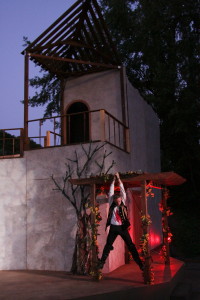
The murder of Hieronomo’s only son, Horatio (played by Erik Johnson, pictured), sets off a chain of murderous events in Marin Shakespeare Company’s outdoor production of “The Spanish Tragedy.”
Photo by Eric Chazankin
“Where Words Prevail Not, Violence Prevails”
Only in the final moments of the play did the production completely rise to the occasion, bring home to message encapsulated by its most famous line. When it blossomed into its full potential, however, it was easy to see why the vicarious power fantasy of revenge, and the sensational violence, was as popular as it was. In much the way that Titus has been rehabilitated in the last half century after nearly three hundred years of dormancy, The Spanish Tragedy seems ripe for rediscovery. The combination of black humor and suppressed rage at state sponsored (or at least tolerated) injustice – of which poor Kyd as a victim when he was tortured and his health permanently destroyed as collateral damage in the campaign to ensnare Christopher Marlowe – was not a Victorian taste, but seems all too apropos these days. We can only thank and admire Marin Shakespeare Company for exploring this gem.
Where words prevail not, violence prevails.
July 20, 2013 § Leave a Comment
Revenge tragedy is a bizarre genre, and these days (Hamlet excepted) it is rarely performed. Although the most popular and exciting genre of Elizabethan and Jacobean times it has now largely slipped from view.
The reason for this is that the genre is built on a view of the justice system as corrupt in favor of the wealthy and powerful. As in Hamlet, the revenger is driven to his desperate course because the government cannot, or will not, do its job. Claudius may be a murderer, but he is also the king and protected by his position as much as by his secret.
Other revenge tragedies of the period have mostly slipped out of the repertoire because their premise is far more firmly grounded in the corruption of justice, which fewer and fewer people feel about their democratic governments. Conventional wisdom says that they had become irrelevant.
I was thinking these thoughts as I sat waiting for a very rare modern performance of Thomas Kyd’s The Spanish Tragedy, one of the earliest and (in its time) most successful of all revenge tragedies, to begin. It was Saturday, July 13, 2013. I was making a final check of my smart phone before turning it off when I first heard that George Zimmerman had been found not guilty in the death of Trayvon Martin.
Watching that performance was very different than what I imagined might be coming. It suddenly had force and pertinence I was not expecting.
Halfway through I heard a line that (having read and taught the play) I should have known was coming, but I had forgotten came from this source: “Where words prevail not, violence prevails.”
I have been thinking a lot about it for many days, not least when I read that – apparently without irony – Zimmerman’s brother complained to the media that Zimmerman feared a vigilante would take justice into his own hands and seek revenge.
Violence becomes cyclical, revenge tragedies remind us, when we no longer trust that justice is blind. I fear that they are relevant again.
Review: ROMEO AND JULIET at CalShakes
July 8, 2013 § 2 Comments
Can it be that the most “authentic” production of a Shakespeare play I’ve seen in years is a modern-dress production of Romeo and Juliet with a cast of seven performing a heavily cut text, accompanied by a pulsing club-inspired sound design? To my great surprise, I believe so.
As a professor of both acting and theater history, I think a lot about what the experience of seeing an original performance of a Shakespeare play must have felt like. It is the effect that I would most want to capture, not the form. We can do a reasonably good job at recreating the look and style of the late sixteenth century theater, but what would have been innovative, contemporary, and engaging then often seems hopelessly stale and distant now that the context has completely changed.
Shana Cooper’s Romeo and Juliet, now playing at the California Shakespeare Theatre near San Francisco, is a stark but simply brilliant, production. It is as far from a museum replica version as possible, yet it recreates all of the Shakespearean theater’s virtues in modern form.
Played on an open stage against no scenic backdrop but the Orinda, Ca. landscape behind CalShakes’ outdoor auditorium, Cooper uses a text-based technique right out of the Elizabethan theater to verbally move us instantly from imaginary location to location on Daniel Ostling’s aggressively thrusting platform set. The visual neutrality focuses all attention on the action, but when it pauses to be beautiful it is breath-taking. Romeo defying stars that you can actually see causes an exhilarating, visceral rush. Lap Chi Chu’s lighting design for the stage is effective, but his subtle lighting of the natural background in the distance, particularly in the eerie tomb scene, is genius.
Performed by an incredibly versatile cast of three women and four men playing some twenty roles in a heavily but skillfully edited version, it was energetically engaging for every moment of the promised (accurately, for once) two hours traffic on the stage. Somewhere between a quarter and half of the traditional text was excised, including all the bit parts. In clumsy hands, that might have given the appearance of financial expediency, but here it focused and sped the narrative so that events felt – as they should – like they were spinning out of control. Early in the second half the scenes in which Romeo and Juliet separately learn he has been banished were intercut in a way that seem stunningly cinematic or, well, Shakespearean. The juxtaposition of the simultaneous scenes was inspired.
The modern dress costumes enhanced the youthful, often rude energy of the performances. Although the period was changed to some quasi-now (where fourteen-year-olds can still be married off at a father’s whim), it read less as a resetting and much more a case of simply becoming invisible to us. I suspect this is the way that contemporary dress on the Elizabethan stage might have affected the Shakespearean audience – it faded into the background, as neutral as the scenery.
The performances were uniformly outstanding. Rebekah Brockman was an unusually aggressive Juliet from her first entrance when she jumped out to frighten the nurse. She has just finished a run of the season’s best production, playing Thomasina in ACT’s Arcadia. Perhaps it is because she was so indelible in that role that she seemed to possess the same combination of tragically under-appreciated intelligence and irrepressible, emerging sexuality here, but it is more probable that she carried it forward to create an equally self-inventing Juliet.
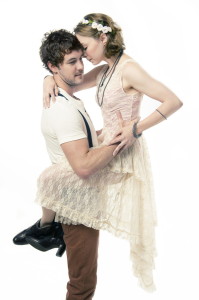
Dan Clegg (Romeo) and Rebekah Brockman (Juliet) in Cal Shakes’ Romeo & Juliet, directed by Shana Cooper; photo by Kevin Berne.
Romeo can be one of the least rewarding roles in the canon. He works incredibly hard in the first half of the play and then slowly fades from view in the second as Juliet’s story eclipses his. Dan Clegg brought unusual charm and skill to the part, and greatly benefited from the extensive cutting of Romeo’s mopiest and dopiest moments. He emerged as a genuinely tragic figure in the tomb scene, most moving when he unsuccessfully sought to scare Paris away to avoid killing him.
The other five cast members all played multiple roles with theatrical verve that made the production electrifying. Nick Gabriel (another veteran of the Arcadia cast) played Tybalt and Paris as entitled hipsters. Domenique Lozano doubled the Prince of Verona with the nurse, and excelled at both parts of this unlikely pairing. Arwen Anderson was a mousy Lady Capulet, but revelatory as Benvolio, where she out-guyed the guys when being one of the guys. Joseph J. Parks was the engine of the first act as the relentlessly and inappropriately libidinous Mercutio. It is, of course, necessary that this comic presence disappear from the last half of the play, and Parks is too irrepressible to hide effectively, but it is too bad that he could not be used for more than a cameo as the apothecary after intermission. He is too good to sacrifice.
The production ultimately rests on the skills of Dan Hiatt, who is onstage almost continuously in the second half as Friar Laurence, quick-changing into Lord Capulet, and then reappearing as the servant Peter. That he could walk to the edge of the platform, slip on a jacket, and return instantly as someone else for scene after scene was a confirmation of what every regular theater-goer in the Bay Area already knows: he is a consummate actor. It is worth the price of admission just to watch his transitions.
The production is so tightly focused, suiting the action to the word and the word to the action, that it is immediately affecting while serving as a model of narrative clarity. One might quibble with the unusual choice to strangle rather than stab Tybalt, only because it renders later references to shedding his blood very odd, but Shana Cooper’s direction is otherwise flawless. The fast-moving staging, stylized fights, smart transitions and beautiful use of the natural surround as scenery combined for the most rewarding (and least gimmicky) Shakespeare I’ve seen in ages. It was fresh and exciting.
I walked away thinking, “I bet that is exactly how it felt at the Globe.”
Review: TAMING OF THE SHREW at the Livermore Shakespeare Festival
July 1, 2013 § 1 Comment
As Director Gary Armagnac disarmingly admits in the notes to his production currently running at the Livermore Shakespeare Festival, The Taming of the Shrew is now a “problem play.” In its time, it was a lightweight comedy about the battle of the sexes won only when the man showed his independent-minded bride some tough love and put her in her place. To play it that way now just reads as painfully misogynistic. If it were not by Shakespeare, it is entirely possible it would be dropped from the repertoire but because it is, the problem now is to figure out how to find something deeper in it. Like any good puzzle, it now has to be “solved.”
Conceptually, Armagnac goes a long way toward rehabilitating Shrew by setting his “Rosie the riveter” production just after the end of World War II, as the troops return home. Petruchio, the protagonist, is portrayed (along with the other male characters) as anxious to get married, settle down and get on with Eisenhower-ifying America – but the women they are coming home to are not the girls they left behind. Armagnac’s resetting highlights the greater social empowerment women felt (and were in danger of losing) from supplying the home work force while men fought the war. That goes a long way to explaining why Kate, the “shrew” of the title, resists with such vitriol the bevy of suitors who want her bucks but not her pluck.
It is the psychologically insightful portrayals of the quarreling couple by Armando McClain and the simply wonderful Jennifer Le Blanc that make it all work. As Petruchio, McClain’s best moment is the soliloquy in which he asks directly if anybody has any better ideas than he does for taming his wife. Although the speech is an extended metaphor about falconry, through subtext he reveals that the only methods this returning army captain has in hand are the ones he used to discipline his troops, and he rightly worries about their current appropriateness.
Le Blanc, who both looks and sounds like a young Helen Hunt, showed us right from the start that the issue was not that she hates men, but that she loves – and fears losing – the scope of her unfettered life. Astonishingly, she somehow never lets us forget she is balancing her genuine fondness for the handsome and confident Petruchio with the desire to retain her independence, including in many scenes where the text has much less substance.
Not that fidelity to the text was much of an issue in the production. Armagnac’s other main conceptual innovation was setting the play right in the very California vineyard where it was being performed, which succeeded in incorporating the beautiful natural setting and led to some very clever moments. (A servant summoning Kate just stuck her head out a second story window and bellowed into the field, from which a grumbling Kate emerged with pruning implements still in hand.)

The mansion on the grounds of Concannon winery that serves as a permanent backdrop for the Livermore Shakespeare Festival
Less successfully, it also meant that all references to Padua were changed to Livermore, Pisa to New York, and from there the floodgates were opened. Horses became jeeps, servants became soldiers, and actual welcome home speeches from the war were inserted into the play. Although resetting the play into a period of rapid, and unsettled, social transformation (not unlike our own) was revelatory, the text was shoehorned into its new shape, and where it would not stretch to fit, just changed wholesale. In previews, many of the biggest laughs from the audience were not at the play’s humor, but at the incongruity of the very unShakespearean inserted material.
The best moments in the production came not from alteration, but from honest delivery of the plot in its new context. Patrick Moore, who already gave one outstanding performance this summer, portraying a loving father in The Liar (the repertory’s other production) delivered again here. As Baptista, he desperately tries to balance the happiness of both his daughters. He is quite moving during Kate’s wedding scene fearing that he’s made a mistake by hastily accepting the mad-seeming Petruchio as her husband to clear the way for Bianca. Rebecca Pingree, another terrific performer cast in both productions, played the minor role of the widow that a suitor must settle for when a rival outmaneuvers him for Kate’s younger sister, Bianca. Pingree brought illuminating gravity to the play’s final scene by playing the widow not as the typical doddering old woman, but as a young girl whose husband was lost in the war.
At least in its final preview, this was a production with an admirable aim that exceeded its grasp. However, with excellent and deeply felt performances from its leads, as well as from the afore-mentioned Pingree and Moore, it still managed to speak to contemporary concerns: it showed us two people negotiating a new kind of relationship in the absence of societal models for doing so. That is a lot to wring out of Shrew.
The production would have been stronger if it had remained faithful to this more serious reading throughout, but the subplots were less carefully considered, and overstuffed with tacked on lazzi. Genuinely successful comic moments were, however, provided by Brian Herndon as an Ensign Pulver-like Tranio, and Jeremy Tribe-Gallardo (an intern with a big future coming) as the funniest Grumio I’ve ever seen.

